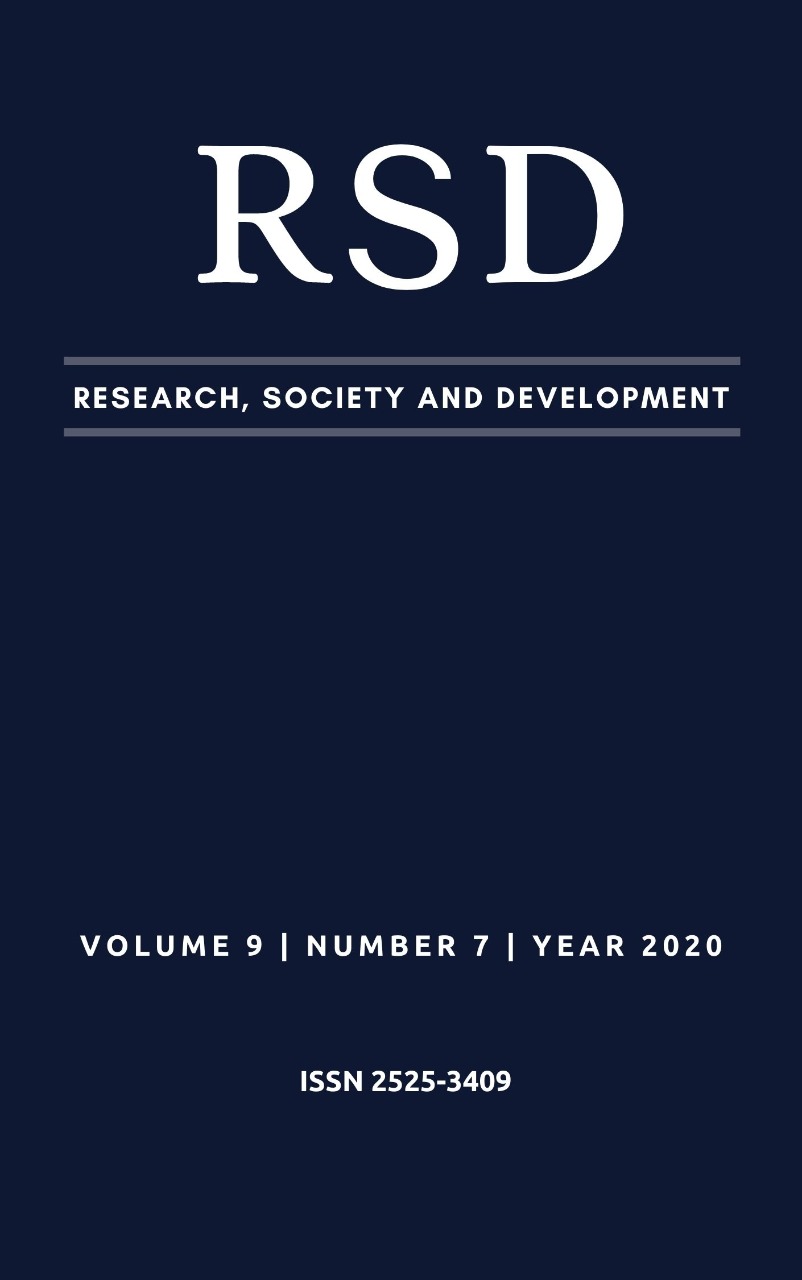Spatial and temporal analysis of visceral leishmaniasis in the State of São Paulo in 1970 to 2014: risk areas increase over time
DOI:
https://doi.org/10.33448/rsd-v9i7.4494Keywords:
Calazar, Distribution, Epidemiology, Record, Surveillance.Abstract
Nowadays, in Brazil, visceral leishmaniasis (VL) is classified as a re-emerging disease, in a clear process of epidemiological transition, along with an increased incidence in endemic areas, and present in four of the five regions of the country. Therefore, this essay aims to analyze the evolution and spatial distribution of VL in São Paulo, since its first record until the year 2014, in order to provide information for public health authorities to improve the control program. By means of an ecological and descriptive study, secondary data obtained from the Centro de Vigilância Epidemológica (CVE) and the Superintendência de Controle de Endemias (SUCEN) of São Paulo were analyzed and treated in a geographic information system (ArcGIS 10.1), with confection distribution maps. It was observed that there are two distinct patterns of distribution of LV in São Paulo: one in the western region, defined by the occurrence of human cases, high prevalence of canine cases and a greater number of municipalities where sand fly is present; the other, represented by the eastern region, characterized by the absence of reporting human cases, even where the sand flies and canine cases are present. It follows that western expansion of canine and human cases following the same expansion route as the vector is not a coincidence, since the phlebotomine sandflies records precede the notifications of the disease in dogs and subsequently in humans. The research is the basis for future studies and provides subsidies for actions of the State Control Program. It is suggested that there is a continuous survey of the presence vector and serological monitoring of dogs as well as education of the population so that it is receptive to euthanasia dogs in the positive cases, since in relation to the vector cycle, nothing can be done.
References
Afonso, M. M. S.; Duarte, R.; Miranda, J. C.; Caranha, L.; & Rangel, E. F. (2012). Studies on the feeding habits of Lutzomyia (Lutzomyia) longipalpis (Lutz & Neiva, 1912) (Diptera: Psychodidae: Phlebotominae) populations from endemic areas of american visceral leishmaniasis in northeastern Brazil. Journal of Tropical Medicine, 2012, 858657.
Baneth, G.; Koutinas, A. F.; Solano-Gallego, L.; Bourdeau, P.; & Ferrer, L. (2008). Canine leishmaniosis – new concepts and insights on an expanding zoonosis: part one. Trends in Parasitology, 24(7), 324-330.
Barcellos, C. & Santos, S. M. (1997). Colocando dados no mapa: a escolha da unidade espacial de agregação e integração de bases de dados em saúde e ambiente através do geoprocessamento. Inf. Epidemiol. do SUS, 1, 21-29.
Barretto, M. P. (1943). Observações sobre a biologia, em condições naturais, dos flebótomos do estado de São Paulo (Diptera, Psychodidae). Universidade de São Paulo, São Paulo.
Brasil. (2014). Manual de vigilância e controle da leishmaniose visceral. Brasília: Ministério da Saúde.
Casanova, C., Colla-Jacques, F. E., Hamilton, J. G., Brazil, R. P., & Shaw, J. J. (2015). Distribution of Lutzomyia longipalpis chemotype populations in São Paulo state, Brazil. PLoS neglected tropical diseases, 9(3), e0003620. https://doi.org/10.1371/journal.pntd.0003620
Costa, A. I. P.; Casanova, C.; Rodas, L. A. C.; & Galati, E. A. B. (1997) Atualização da distribuição geográfica e primeiro encontro de Lutzomyia longipalpis em área urbana no Estado de São Paulo, Brasil. Revista de Saúde Pública, 31(6), 632-633. https://doi.org/10.1590/S0034-89101997000700012
Coura-Vital, W., Marques, M. J., Veloso, V. M., Roatt, B. M., Aguiar-Soares, R. D., Reis, L. E., Braga, S. L., Morais, M. H., Reis, A. B., & Carneiro, M. (2011). Prevalence and factors associated with Leishmania infantum infection of dogs from an urban area of Brazil as identified by molecular methods. PLoS neglected tropical diseases, 5(8), e1291. https://doi.org/10.1371/journal.pntd.0001291
Dantas-Torres, F. (2007). The role of dogs as reservoirs of Leishmania parasites with emphasis on Leishmania (Leishmania) infantum and Leishmania (Viannia) brazileinsis. Veterinary Parasitology, 149, 139-146.
Dantas-Torres, F. (2009). Canine leishmaniosis in South America. Parasites Vectors, v. 2 (1)., 2009.
Gomes, A. C.; Galati, E. A. B.; Casanova, C.; Domingos, M. F.; Marques, G. R. A. M.; & Neves, V. L. F. Analysis of the geographical distribution of leishmaniasis vectors in the state of São Paulo Brazil. Bol Dir Malariol San Amb, 1995; 35(Supl. 1): 143–146.
Martinelli, M. (2008). Mapas da geografia e cartografia temática. São Paulo: Contexto.
Martinelli, M. (2009). Relevo do Estado de São Paulo. Confins, 7.
Missawa, N. A.; Lorosa, E. S.; & Dias, E. S. (2008). Preferência alimentar de Lutzomyia longipalpis (Lutz & Neiva, 1912) em área de transmissão de leishmaniose visceral em Mato Grosso. Revista da Sociedade Brasileira de Medicina Tropical, 41(4), 365-368. https://doi.org/10.1590/S0037-86822008000400008
São Paulo. (2003). II Informe técnico leishmaniose visceral americana. São Paulo, São Paulo.
Shimabukuro, P. H.; Silva, T. R.; Fonseca, F. O.; Baton, L. A.; & Galati, E. A. (2010). Geographical distribution of American cutaneous leishmaniasis and its phlebotomine vectors (Diptera: Psychodidae) in the state of São Paulo, Brazil. Parasites Vectors, 3:121.
São Paulo. (2006). Relatório Leishmaniose Visceral. São Paulo, São Paulo.
Downloads
Published
Issue
Section
License
Authors who publish with this journal agree to the following terms:
1) Authors retain copyright and grant the journal right of first publication with the work simultaneously licensed under a Creative Commons Attribution License that allows others to share the work with an acknowledgement of the work's authorship and initial publication in this journal.
2) Authors are able to enter into separate, additional contractual arrangements for the non-exclusive distribution of the journal's published version of the work (e.g., post it to an institutional repository or publish it in a book), with an acknowledgement of its initial publication in this journal.
3) Authors are permitted and encouraged to post their work online (e.g., in institutional repositories or on their website) prior to and during the submission process, as it can lead to productive exchanges, as well as earlier and greater citation of published work.


